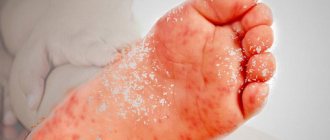Despite the fact that sea water has a wound-healing effect and can relieve a person of many skin pathologies, it is a fairly strong allergen and can cause a negative reaction in the body. Redness, large spots with blurred edges cover the face and body of a person, causing discomfort, causing itching, burning and dry skin.
Why does itching and rash occur?
The appearance of itching and rash, as a rule, is caused by various microorganisms that can live in both sea and fresh water. “Rashes accompanied by itching, burning or pain often occur both on the sea coast and when swimming in a freshwater body,” says Yuri Khaliulin, allergist, immunologist, dermatovenerologist of the European Medical Center, PhD, associate professor. - Of course, there is a greater chance of having unpleasant skin manifestations in swimming areas that are not an official beach, where wild or domestic animals come, and where the bottom of the reservoir has not been explored.
This is associated with the possibility of contamination of water and soil on the shore and, accordingly, an increased risk of infection.” Microorganisms can infect the skin both in water and on the shore. “Disease pathogens can be on the surface of the shore or in the water, and it is easier for them to invade if a person walks along the shore barefoot, especially if there is damage to the skin of the feet. Concomitant diseases that lead to decreased immunity are important,” adds Yuri Khaliulin. “The “offenders” can be very diverse: marine or freshwater inhabitants, microbes, parasites, and occasionally fungi.”
Let's take a closer look at them.
Unconventional methods
Alternative medicine can help soothe inflamed skin.
- Thin slices of fresh cucumber and cabbage leaves applied to the rash areas relieve itching.
- Dried chamomile flowers and thyme herb are mixed in equal proportions. Place 100 g of dry raw materials in a thermos and add 1 liter of boiling water. After 10 hours, the reddened and itchy skin is treated with the prepared infusion. Treatment lasts at least a week.
- Thyme, chamomile, celandine in a ratio of 2:2:1 are crushed and poured with a liter of boiling water. Leave for 4-5 hours. The inflamed dermis is treated with the strained infusion 5-6 times a day. The effect will be noticeable after the first two days of use.
It is important to remember that the use of any medicinal compositions is possible only after consulting a dermatologist.
Skin diseases that may occur after swimming in fresh water
Of course, swimming in not every pond and lake is fraught with these diseases, but you should still be wary of them.
Leptospirosis occurs among lovers of water tourism, and is caused by microbes from the class of spirochetes. Other names for this disease are pretibial fever, Fort Bragg fever, ictero-hemorrhagic fever, Vasiliev-Weil disease. “Leptospirosis occurs infrequently, but is common in all regions except the Arctic. Infection occurs by penetration through damaged skin upon contact with contaminated soil near the shore of a river or lake, says Yuri Khaliulin. — Two to three days after infection, inflammation of the skin of the legs, high fever, headaches, nausea and vomiting, and conjunctivitis occur. Jaundice may develop due to damage to the liver and spleen. Inflammation of the heart muscle may develop. Treatment is based on antibiotics.”
Schistosomiasis. The disease occurs in Africa, the Middle East, the Caribbean, South America, China, Indonesia, and the Philippines. “Skin manifestations of schistosomiasis initially manifest as mild itching and papular rashes on the feet and other areas of the skin after swimming in polluted bodies of water containing cercariae (floating larvae of parasitic flatworms). The parasites that cause this disease penetrate the venous bloodstream of the human bladder or intestines, warns Yuri Khaliulin. — After an asymptomatic incubation period, a sudden illness may develop with fever and chills, pneumonia. The rash most often occurs on the skin of the genitals, perineum and buttocks. Vegetating soft masses, fistulas, extensive hard masses are accompanied by serous-purulent discharge.”
As a rule, schistosomiasis is treated with antiparasitic drugs.
Dermatitis caused by blood-sucking insects. Not only people like to relax near the water, but also blood-sucking insects - horseflies, mosquitoes.
“After a bite, itchy rashes remain due to the toxins released into the blood. In some people, the rashes are very persistent and large, which depends on the individual reaction of the immune system,” says Yuri Khaliulin. - In order to make these itchy rashes go away faster, in mild cases you can use gels with an antihistamine. But in case of a severe reaction, this gel will not help much. Then it is preferable to use an ointment containing a strong corticosteroid with an antibiotic. And take a second-generation antihistamine orally for several days.”
External repellents can help avoid or reduce the likelihood of being bitten by these insects.
Treatment and prevention of rashes
If a small red rash appears on your body while on vacation at sea, you should not immediately panic. First you need to try to find out the reasons for this phenomenon.
Such problems often arise among those tourists who do not know how to choose the right time to visit the beach. From 11 a.m. to 3 p.m., the intensity of ultraviolet radiation increases sharply, which causes allergies and other phototraumatic effects.
People with pale, sensitive skin need to be especially careful at this time, as their bodies do not produce enough melanin pigment, which helps neutralize the sun's rays.
They need to use tanning products. The protective cream cools the skin and protects it from sun rays, significantly weakening their influence.
The sea contains a lot of mineral salts, so it produces a drying effect. People with oily skin types experience a significant improvement in the condition of their skin after bathing.
But if your skin is already dry, it becomes more sensitive to everything and can easily become inflamed when exposed to very salty water.
As a rule, an allergic reaction develops, which causes the appearance of dermatitis, accompanied by severe itching.
To avoid this, it is advisable for people with sensitive skin to lubricate their body with a rich cream before each dive into water. After swimming, you should immediately dry yourself with a dry towel or take a shower with fresh water.
READ ALSO: Allergy to Amoxiclav: symptoms, treatment methods, reviews
The measures taken will help avoid drying out the skin, since it is especially vulnerable on the beach - after all, it is affected by three elements at once: the sun, water and wind. The wind dries the skin, leaving a film of mineral salts on it after the water evaporates. This increases the burning effect of sunlight and causes immunopathological reactions.
What to do about sun allergies? Video:
Skin diseases that may occur after swimming in the sea
Many people believe that harmful microorganisms simply do not live in salt water. This is wrong. Here is a list of skin diseases that can develop after swimming in the sea.
Black mycosis ( tinea nigra ) is found in the tropics, along the gulf coast. “The disease is caused by the fungus Hortea werneckii. Brown or black spots appear on the skin of the feet or hands. This rash can be mistaken for a mole or melanoma. However, this disease is quite harmless and brings a person more of an aesthetic problem than an impact on health. It can be treated with external antifungal drugs,” adds Yuri Khaliulin.
Infection caused by the microbe vibrio vulnificans is characteristic of the Atlantic coast. Skin damage is possible when an open skin wound comes into contact with contaminated seawater. “The disease is acute. After a day or two, skin redness, swelling, hemorrhagic blisters and ulcers, and high body temperature appear. Necrosis of surrounding tissues may develop. Treatment is antibiotics, surgical excision of the affected tissue,” says Yuri Khaliulin.
Another marine microbial infection, aeromonas hydrophilia , can invade a wound following a water injury, resulting in inflammation of the soft tissue at the site of injury. “Gangrene may develop. Cases of this infection have been described on the Black Sea coast, in particular in Bulgaria. Antibiotics are used in treatment,” warns Yuri Khaliulin.
Itching and rash can also occur as a result of contact with marine life. For example, jellyfish, physalia or cnidarians (jellyfish larvae). “Dermatitis also develops after skin contact with other sea creatures: sea anemones, corals, special tiny seaweed dermatitis, sea urchins,” says Yuri Khaliulin.
Do the sea and sun help with acne*?
Sea water is saturated with calcium, magnesium, potassium, and other substances that help in the process of getting rid of acne*. The salt it contains (35 g per 1 liter) has antiseptic and anti-inflammatory effects. It promotes wound healing and regulation of sebum secretion181.
Sea salt has exfoliating properties and helps open pores, which helps cleanse them. But the paradox is that the appearance of acne* after the sea can also be associated with exposure to salt. It can dry out the skin and disrupt its barrier functions, so after the sea it is important to thoroughly wash off its residues from the body and face181.
Skin diseases that can develop after swimming in any body of water
Doctors also identify a group of skin diseases that can be contracted in any body of water or even a swimming pool.
Swimming pool granuloma. It is caused by an atypical mycobacterium, micobacterum marinum. “Infection is possible in both sea and fresh water. Infection occurs in lakes or on the shore of a lake or lagoon, or when working with aquariums, when the skin is damaged, in particular from fish fins. Some time after infection, a slowly developing, painless redness and thickening occurs at the site of infection. The infection may spread along the lymphatic tract and various complications, including damage to the ligaments and bones,” warns Yuri Khaliulin.
Cercarial dermatitis manifests itself as a very itchy, widespread rash. “Its appearance is caused by parasites, cercariae, whose hosts are animals, waterfowl and rodents. During swimming, colorless microorganisms, slightly less than 1 mm in size, attach to the skin, says Yuri Khaliulin. “Unlike schistosomiasis, they die in the skin and cannot enter the bloodstream or deeper tissues. Upon leaving the water, a person feels itchy and an erythematous rash appears, which disappears after a few hours. And after 10-15 hours, the symptoms resume, and erythematous spots and papules develop on the entire surface of open areas of the body that were in the water. Spontaneous recovery occurs after a few days.”
You can reduce the risk of disease if you take a shower after swimming in a pond and thoroughly dry your skin with a towel.
Creeping rash (larva migrans) is found in all tropical and subtropical countries. “Those who walk barefoot on the beach can become infected with this parasitic infection. The feet are most often affected. A rash in the form of a migrating convoluted subcutaneous cord appears 4 days after infection. The larva does not infect human internal organs. This disease is treated with antiparasitic drugs,” says Yuri Khaliulin.
Reaction to the sun
Ultraviolet radiation can cause hypersensitivity in humans. Such processes are accompanied by rashes in the form of papules, vesicles, accompanied by the separation of serous exudate, thickening, roughness of the skin, pigmentation disturbances, and the appearance of grooves are observed.
In healthy people, as a rule, this is rare, mainly occurring in:
- infants;
- children with weakened immune systems;
- people with too light skin (Celtic type);
- old people;
- persons with pathologies of the liver, kidneys, as well as endocrine and immune systems.
There may be other types of immunopathological reactions, phototraumatic and phototoxic. In the first case, it is sunburn. Probably everyone is familiar with how hot and sore the skin is after spending an excessive amount of time on the beach.
Phototoxic burn also occurs as a result of exposure to sunlight. However, here the cause is drugs, foods or other substances that enter the body and produce a photosensitizing effect.
More often, people whose skin is too white or pale are susceptible to allergies. Traumatic effects occur very often.
In addition, photosensitizing substances (PS) often aggravate the situation even in people with normal skin type that is resistant to ultraviolet rays.
Many drugs contain VW in their composition, for example:
- group of tetracyclines (antibiotics);
- neuroleptics;
- sulfonamides;
- antifungals, for example, griseofulfin and some others;
- ethacridine lactate;
- oral contraceptives;
- tar.
Since the main purpose of these drugs is different, their photosensitizing effect is considered as a side effect. Another cause of photodermatosis can be contact with the skin of the juice of plants containing PV.
READ ALSO: Hygiene problems or illness? Cosmetologist-trichologist about dandruff and ways to combat it
Sunburn may occur after direct contact with them. These plants include angelica officinalis, angelica silica and several species of hogweed.
How to prevent skin diseases after swimming?
In some cases (as with cercariasis), it is enough to simply take a shower after bathing and vigorously rub the skin with a towel. But the most reliable way to prevent skin diseases is simply not to visit “unverified” swimming places. “Measures to prevent various injuries from aquatic life include resting on a clean beach where swimming is allowed, wearing shoes on the beach if you are not going to go into the water, and using repellents,” adds Yuri Khaliulin.
If inflammation of the skin develops after being near water, you should consult a doctor if possible.
Treatment
Therapeutic measures are aimed at getting rid of unpleasant symptoms. If the cause of the disease is exposure to the sun, you will have to avoid visiting the beach. Sunburn can trigger the development of the disease. This can be avoided by using special protective creams that are applied to the body before leaving the house.
Redness can be eliminated with the help of medicinal ointments and lotions, which can be prescribed by a dermatologist. If there is an itchy rash on the patient's body, more thorough treatment will be required:










